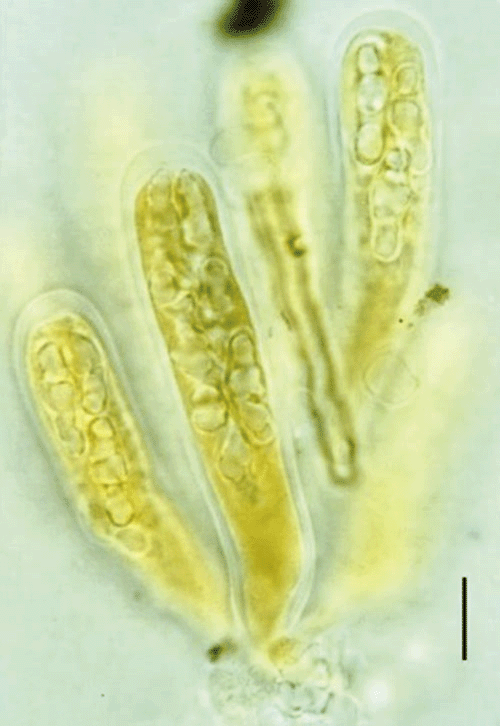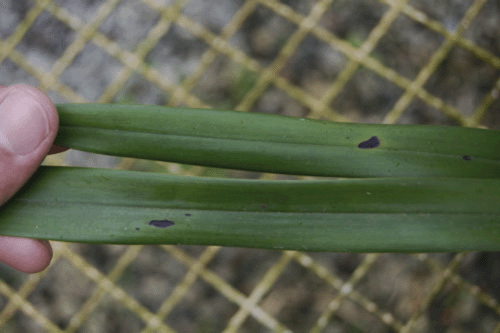First report of Guignardia endophyllicola leaf blight on Cymbidium (Orchidaceae) in Brazil
M. Silva A and O. L. Pereira A BA Departamento de Fitopatologia, Universidade Federal de Viçosa, Viçosa, M.G. 36570-000, Brazil.
B Corresponding author. Email: oliparini@ufv.br
Australasian Plant Disease Notes 2(1) 31-32 https://doi.org/10.1071/DN07015
Submitted: 19 January 2007 Accepted: 7 March 2007 Published: 29 March 2007
Abstract
Leaf blight caused by Guignardia endophyllicola is reported for the first time on Cymbidium (Orchidaceae) in Brazil.
Hybrids of Cymbidium are among the most important commercial orchids cultivated in Brazil. In June 2006, leaves of an undetermined Cymbidium hybrid showing severe necrotic symptoms were observed in an orchid nursery in Viçosa (State of Minas Gerais, Brazil). Leaf lesions initially were punctiform abaxially becoming circular, coalescing and leading to extensive necrosis. No fungal structures were found on diseased tissues; however, culturing of surface sterilised fragments of such necrotic tissue in V8 juice agar repeatedly resulted in pure dense blackish fungal cultures. These cultures later sporulated in culture and were further examined.
The fungus had the following morphology (VIC 30428): pseudothecia intermixed among pycnidia, unilocular, subglobose, solitary or in groups, black, with a stromatic wall composed of several layers of compressed dark brown cells; asci bitunicate (Fig. 1), subclavate to cylindrical, eight-spored; ascospores biseriate, 13–17 × 3–5 µm, one-celled, fusiform-elliptical, broad in middle, hyaline, with a distinct mucilaginous appendages at both ends; pycnidia intermixed among pseudothecia, variable in shape, black, ostiolate; conidia one-celled, hyaline, obovate to pyriform, 9–14 × 5–7 µm, surrounded by a thick mucilaginous coat, with a hyaline apical appendage, 6–12 µm long. Material examined: VIC 30428, dried culture, Campus UFV, Viçosa, State of Minas Gerais, Brazil, M. Silva & O.L. Pereira, 10 June 2006.

|
The fungus fitted well within the description of Guignardia endophyllicola, a species previously known only as an endophyte of ericaceous plants (Okane et al. 2001). Nevertheless, its anamorph, Phyllosticta capitalensis, is a well-known fungal pathogen of the family Orchidaceae (Cash and Watson 1955; van der Aa and Vanev 2002). Mendes et al. (1998) did not record the occurrence of P. capitalensis in Brazil. However, in this country, P. capitalensis has been previously reported on the orchid genus Stanhopea, host in which the type species was described (Nag Raj 1993; van der Aa and Vanev 2002).
Mycelial plugs containing reproductive structures were taken from a 10-day-old culture growing on V8 juice agar and placed on healthy leaves of hybrid Cymbidium. The inoculated leaves were kept inside moistened plastic bags for 2 days and then in a greenhouse at 25°C. After 7 days, symptoms similar to those previously observed were detected (Fig. 2) and the fungus was reisolated from infected parts. The control leaves, on which V8 juice agar plugs were deposited, remained healthy.

|
Despite the fact that P. capitalensis is regarded to be distributed all over the world on Orchidaceae (van der Aa 1973; Uchida 1994), this is the first report of this fungal species causing leaf blight on Cymbidium in Brazil and the first worldwide report of its teleomorph (G. endophyllicola) being associated with this orchid disease.
Acknowledgements
The authors thanks the Fundação de Amparo à Pesquisa do Estado de Minas Gerais (FAPEMIG) for financial support.
van der Aa HA
(1973) Studies in Phyllosticta I. Studies in Mycology 5, 1–110.

Cash EK, Watson AJ
(1955) Some fungi on Orchidaceae. Mycologia 47, 729–747.
| Crossref | GoogleScholarGoogle Scholar |

Okane I,
Nakagiri A, Ito T
(2001) Identity of Guignardia sp. inhabiting ericaceous plants. Canadian Journal of Botany 79, 101–109.
| Crossref | GoogleScholarGoogle Scholar |

Uchida JY
(1994) Diseases of orchids in Hawaii. Plant Disease 78, 220–224.



